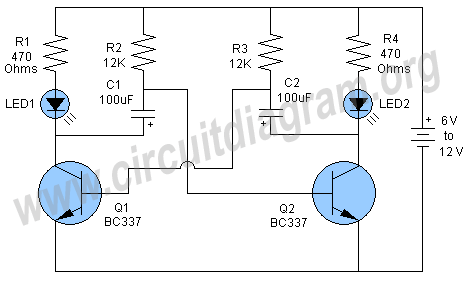
555 organ circuit

This schematic illustrates a simple 555 organ circuit, which consists of two main components: the 555 timer circuit that generates tones and an LM386 amplifier for driving an 8-ohm speaker. The circuit produces slightly different tones when each switch, labeled S1 to S7, is pressed, functioning similarly to a piano. It is recommended to use 100K small variable resistors for R1 to R7. The frequency of the tones can be modified by adjusting these variable resistors, allowing for tonal variations akin to piano notes. If necessary, these variable resistors can be replaced with fixed resistors. Additional switches with variable resistors can be integrated before S1 to expand the tonal range. Furthermore, the overall tone for all switches from S1 to S7 can be adjusted simultaneously by modifying the variable resistor R9. The circuit requires a DC power supply of 9 to 12 volts.
The 555 organ circuit utilizes the 555 timer in astable mode to generate audio frequencies corresponding to piano notes. The frequency output is determined by the resistors R1 to R7, which are connected to the control pins of the 555 timer. Each switch (S1 to S7) is linked to a different resistor, allowing the user to select various tones by closing the switches. The LM386 amplifier is employed to amplify the audio signal produced by the 555 timer, ensuring adequate power is delivered to the 8-ohm speaker for clear sound output.
In addition, the circuit can be enhanced by incorporating more switches with variable resistors, which would enable the generation of additional tones. This flexibility is particularly useful for users seeking a wider range of musical notes. The variable resistor R9 serves as a master control, providing a means to adjust the pitch of all selected tones simultaneously, facilitating fine-tuning of the overall sound.
Powering the circuit with a DC supply of 9 to 12 volts ensures optimal performance of both the 555 timer and the LM386 amplifier. Proper decoupling capacitors should be included near the power supply pins of the ICs to minimize noise and ensure stable operation. Overall, this simple yet effective circuit design offers a straightforward approach to creating a compact electronic musical instrument.Here is a schematic of a simple 555 organ circuit. The circuit is consist of two parts first 555 circuit of organ and second lm386 amplifier for driving 8 ohms speaker. The circuit will generate slightly different tone by pressing each switch from S1 to S7 and work like a piano.
Use 100K small variable resistors for R1 to R7. The frequency of tone can be changed by adjusting the variable resistors R1 to R7, adjust them like piano tone 1, 2, 3, 4, 5. , and then change these variable resistors to fix resistors if required. More switches with variable resistors can be added before S1 for more tones. You can also change tone of all switch from S1 to S7 at once by adjusting the variable resistor R9. Apply 9 to 12 volt DC to power the circuit. 🔗 External reference
The 555 organ circuit utilizes the 555 timer in astable mode to generate audio frequencies corresponding to piano notes. The frequency output is determined by the resistors R1 to R7, which are connected to the control pins of the 555 timer. Each switch (S1 to S7) is linked to a different resistor, allowing the user to select various tones by closing the switches. The LM386 amplifier is employed to amplify the audio signal produced by the 555 timer, ensuring adequate power is delivered to the 8-ohm speaker for clear sound output.
In addition, the circuit can be enhanced by incorporating more switches with variable resistors, which would enable the generation of additional tones. This flexibility is particularly useful for users seeking a wider range of musical notes. The variable resistor R9 serves as a master control, providing a means to adjust the pitch of all selected tones simultaneously, facilitating fine-tuning of the overall sound.
Powering the circuit with a DC supply of 9 to 12 volts ensures optimal performance of both the 555 timer and the LM386 amplifier. Proper decoupling capacitors should be included near the power supply pins of the ICs to minimize noise and ensure stable operation. Overall, this simple yet effective circuit design offers a straightforward approach to creating a compact electronic musical instrument.Here is a schematic of a simple 555 organ circuit. The circuit is consist of two parts first 555 circuit of organ and second lm386 amplifier for driving 8 ohms speaker. The circuit will generate slightly different tone by pressing each switch from S1 to S7 and work like a piano.
Use 100K small variable resistors for R1 to R7. The frequency of tone can be changed by adjusting the variable resistors R1 to R7, adjust them like piano tone 1, 2, 3, 4, 5. , and then change these variable resistors to fix resistors if required. More switches with variable resistors can be added before S1 for more tones. You can also change tone of all switch from S1 to S7 at once by adjusting the variable resistor R9. Apply 9 to 12 volt DC to power the circuit. 🔗 External reference





